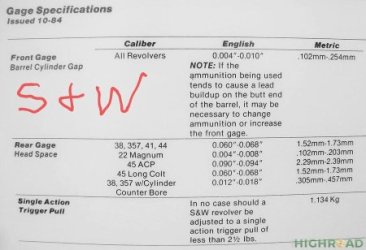Bryan Austin
Member
- Joined
- Mar 14, 2020
- Messages
- 65
- Reaction score
- 70
The "weak link" (per this discussion) in revolver strength is typically the thickness of material between the cylinder wall and cylinder lock detent.
There is one difference that 44MAG N-frames have that not all N-frames have & that's the bolt block added as part of the Endurance Package to keep the cylinder from unlocking & rotating back a chamber under recoil.
I've not made a full inventory check for this feature on all of my N-frames but while I do know that my modern 41MAGs (57/357/657) also have this I can say that my .45s & 10AUTO N-frames do not.
So far I haven't remembered to check my .357s while they were apart to verify them.
.
329PD bolt block - disengaged
.

.
.
329PD bolt block - engaged
.

.
The logistics of tracking frames with 2 heat treats don't make any sense, plus having done heat treating and knowing others who do it, as well as someone who was a foreman at the shop that HTed all the Leather man tools, I don't know how you would save much, if any, time or cost doing some with an inferior method and others with a best quality one.
Plus, I have an Ames harness tester and I have found the frames to all be very close to the same hardness. But, then hardness is only one indicator. With cylinders and frames you need really good yield strength. Usually higher hardness indicates higher yield strength, but all the frames I have tested were fairly soft. So far down on the RC scale I got more consistent readings using a ball indicator and the B scale rather than a diamond and the C scale.
That yield strength is the point at which a material takes a load and still return to its original shape. Whereas tensile strength describes the maximum stress that a material can handle before breaking.
I don’t want to beat a dead horse but do want to clarify when and in what models this “bolt block” mechanism was added. Am I correct in thinking now that it was not part of the endurance package introduced with the 29-3E/629-2E? If so when did appear?




Yes they are!I recently got an 8-3/8” Model 25-5 and also have a 25-10. Sierra shows two sets of data for .45 Colt: 14,000 psi and 30,000 psi. They explicitly state that the higher pressure is not suitable for a S&W 25-5. However, the Model 25s have to be more robust than a SAA dont they?
There are three pressure levels for .45 Colt:
- 14,000 psi for older .45 Colts;
- 21,000 psi for newer modern era smokeless powder .45 Colts; and
-30,000-32,000 psi load for Ruger only and T/C handguns, as well as the Winchester Model 1892 and Rossi 92 lever action rifles.
Those 30,000-32,000 psi loads give essentially .44 magnum level performance. But frankly case life at higher pressures in the .45 Colt is very short. The .45 Colt chamber was made with a .007” taper from base to case mouth to facilitate extraction from black powder fouled chambers and those chamber dimensions persist today for the parallel case wall .45 Colt.
That means the case expands in an increasing and linear manner from mouth to base which stretches the case walls significantly at higher pressures. At 30,000 psi you can expect spider cracks in the case walls in as little as 3 or 4 reloads. At most you’ll be lucky to get 5-7 loads in the case before it’s scrap.
In other words, if you want .44 Mag performance from a .45 Colt, just get a .44 Mag.
——
The S&W 25, like the 625, runs just fine at 21,000 psi .45 ACP pressures. I would not push it to 23,000 psi .45 ACP +P pressures as S&W doesn’t recommend it for the 625.
And there’s no real point.

